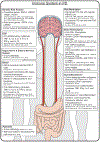Innate and adaptive immune responses in Parkinson's disease
- PMID: 32247364
- PMCID: PMC7185735
- DOI: 10.1016/bs.pbr.2019.10.006
Innate and adaptive immune responses in Parkinson's disease
Abstract
Parkinson's disease (PD) has classically been defined as a movement disorder, in which motor symptoms are explained by the aggregation of alpha-synuclein (α-syn) and subsequent death of dopaminergic neurons of the substantia nigra pars compacta (SNpc). More recently, the multisystem effects of the disease have been investigated, with the immune system being implicated in a number of these processes in the brain, the blood, and the gut. In this review, we highlight the dysfunctional immune system found in both human PD and animal models of the disease, and discuss how genetic risk factors and risk modifiers are associated with pro-inflammatory immune responses. Finally, we emphasize evidence that the immune response drives the pathogenesis and progression of PD, and discuss key questions that remain to be investigated in order to identify immunomodulatory therapies in PD.
Keywords: Alpha-synuclein; Immune system; Inflammation; Microbiota; Microglia; Parkinson's disease; T cells.
© 2020 Elsevier B.V. All rights reserved.
Figures




References
-
- Abbott RD, Petrovitch H, White LR, Masaki KH, Tanner CM, Curb JD, Grandinetti A, Blanchette PL, Popper JS, Ross GW, 2001. Frequency of bowel movements and the future risk of Parkinson’s disease. Neurology 57, 456–462. - PubMed
-
- Ahmed I, Tamouza R, Delord M, Krishnamoorthy R, Tzourio C, Mulot C, Nacfer M, Lambert JC, Beaune P, Laurent-Puig P, Loriot MA, Charron D, Elbaz A, 2012. Association between Parkinson’s disease and the HLA-DRB1 locus. Mov. Disord 27, 1104–1110. - PubMed
-
- Akiyama H, Mcgeer PL, 1989. Microglial response to 6-hydroxydopamine-induced substantia nigra lesions. Brain Res. 489, 247–253. - PubMed
Publication types
MeSH terms
Grants and funding
LinkOut - more resources
Full Text Sources
Medical
Miscellaneous

